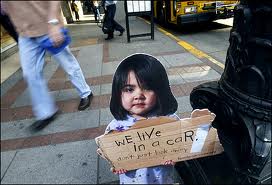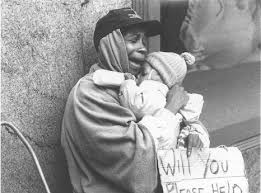|
|
 |
| « December 2025 » | | Su | Mo | Tu | We | Th | Fr | Sa | | | 1 | 2 | 3 | 4 | 5 | 6 | | 7 | 8 | 9 | 10 | 11 | 12 | 13 | | 14 | 15 | 16 | 17 | 18 | 19 | 20 | | 21 | 22 | 23 | 24 | 25 | 26 | 27 | | 28 | 29 | 30 | 31 |
|
 |
 |
 |
 |
|
|
|
|
 |
Children living in a
Homeless and Low income
Environment.
The Facts.
How Many Children and Youth Experience Homelessness?
According to the most recent federal data, 1,065,794 homeless students were enrolled by U.S. preschools and K-12 schools in the 2010-2011 school year. This is the highest number on record, and a 13 percent increase over the 2009-2010 school year. The number of homeless children enrolled in public schools has increased 57 percent since the beginning of the recession (2006-2007 school year).
It is important to note that this number is not an estimate of the prevalence of child and youth homelessness; in fact, it is an underestimate, because not all school districts reported data to the U.S. Department of Education, and because the data collected represents only those children identified and enrolled in school. Finally, the number does not include all preschool-age children, or any infants and toddlers.
Why Are Children and Youth Homeless?
Homelessness is a lack of permanent housing resulting from extreme poverty and/or unsafe or unstable living environments (e.g., conditions of domestic violence, child abuse and neglect, or natural or other disasters).
Two trends are largely responsible for the rise in family homelessness over the past several decades: a growing shortage of affordable rental housing and a simultaneous increase in severe poverty. The mean income of families experiencing homelessness is less than half the poverty line. There is a rising gap between income and housing costs for low-income individuals. For example, a full-time minimum wage worker cannot afford the fair market rent for housing in every county and state within the United States (see Out of Reach, by the National Low Income Housing Coalition).
Unaccompanied homeless youth include young people who have run away from or been thrown out of their home or been abandoned by their parents. The primary causes of homelessness among unaccompanied youth are physical and sexual abuse by a parent or guardian, neglect, parental substance abuse, and extreme family conflict. It is estimated that between 1.6 and 1.7 million youth run away or are forced to leave home each year.
How Does Homelessness Affect Children and Youth's Education?
In a life filled with uncertainty, loss, and deprivation, school is a place of safety, structure, and opportunity. Yet homeless children and youth face unique barriers to education. These barriers include being unable to meet enrollment requirements (including requirements to provide proof of residency and legal guardianship, and school and health records); high mobility resulting in lack of school stability and educational continuity; lack of transportation; lack of school supplies and clothing; and poor health, fatigue, and hunger. When these barriers are not addressed, homeless children and youth often are unable to attend, or even enroll in, school, which prevents them from obtaining the education that is both their legal right and their best hope of escaping poverty as adults.
What Educational Rights Do Homeless Children and Youth Have?
Subtitle VII-B of the McKinney-Vento Homeless Assistance Act (referred to as the McKinney-Vento Act) is a federal law designed to remove barriers to education created by homelessness, and thereby increase the enrollment, attendance, and success of children and youth experiencing homelessness. The McKinney-Vento Act was passed in 1987 and reauthorized as part of the No Child Left Behind Act in 2001. The McKinney-Vento Act requires that state and local educational agencies provide students experiencing homelessness with access to school and support for their attendance and success. Key provisions of the Act include:
- Students who are homeless can remain in one school, even if their temporary living situation is located in another school district or attendance area, if that is in their best interest. Schools must provide transportation.
- Children and youth who are homeless can enroll in school and begin attending immediately, even if they cannot produce normally required documents, such as birth certificates, proof of guardianship, immunization records, or proof of residency.
- Every school district must designate a homeless liaison to ensure the McKinney-Vento Act is implemented in the district. Homeless liaisons have many critical responsibilities, including identification, enrollment, and collaboration with community agencies.
- Every state must designate a state coordinator to ensure the McKinney-Vento Act is implemented in the state.
- Both state coordinators and homeless liaisons must collaborate with other agencies serving homeless children, youth, and families to enhance educational attendance and success.
- State departments of education and school districts must review and revise their policies and practices to eliminate barriers to the enrollment and retention in school of homeless children and youth.
The McKinney-Vento Act contains many other provisions designed to support the education of children and youth experiencing homelessness. It is a critical tool in any effort to help these students meet their educational goals. . For additional awareness and training materials, including posters, please visit the National Center for Homeless Education.
According to state departments of education across the country, 35% of homeless children lived in shelters, 34% were in group situations with family or friends, and 23% were in motels or other places in 2000.
Homeless children and youth face a number of problems. These include developmental problems, abuse and neglect, lack of effective education, among others. The National Law Center created a report in June 2006 summarizing basic facts about our homeless youngsters. Developmental Problems
Lack of a stable living situation can be mentally and physically harmful to children and youth.
Homeless infants are four times more likely to require special care at birth than other infants. Toddlers who are homeless usually develop at a slower pace than those who have stable homes. Homeless children are twice as likely to have a learning disability and are three times more likely than other children to have emotional or behavioral problems
33% of runaway youth state it was because of sexual abuse, while 50% report it was due to physical abuse. Sheltered homeless children have twice as many ear infections, five times more gastrointestinal problems, six times as many speech problems, and four times as many have asthma.
Abuse and Neglect
25% of the adult homeless population report having experienced physical and/or sexual abuse as a child by someone with whom they lived. Homeless children are physically abused at twice the rate of other children.
33% of the adult homeless population report running away from home as children and 27% report living in foster care or in a group home. 22% of the homeless population report being forced to leave home.
21% of the adult homeless population experience homelessness during childhood. Homeless children are three times as likely to have been sexually abused as other children.
Lack of Education Perpetuates Homelessness
38% of adult homeless individuals do not have a high school degree by age 18 and 53% report having dropped out of either elementary, middle, or high school for an indefinite period of time. 18% of the homeless population say they were expelled from school and only 62% of the homeless population have a high school diploma.
|
|
 |
 |
 |

|
|
|




